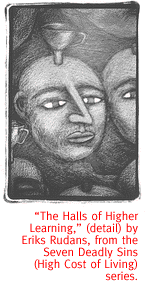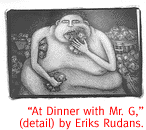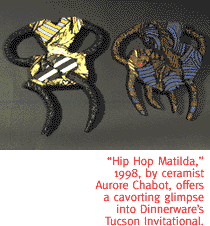

|

The Dinnerware Invitational Exhibit Blends Social Indictments With Whimiscal Artistry.
By Margaret Regan
ERIKS RUDANS, KNOWN around town as a "painters' painter,"
has gone in for fierce social criticism of late.
A few years back, he was painting luminous saints' heads, glowing
in their golden haloes, and Gaugin-like innocents in tropical
gardens. True, his saints and naked women were never entirely
ethereal. In one memorable show at Etherton Gallery, Rudans's
female saints had all-knowing eyes. On their hands, where their
bleeding stigmata ought to have been, were labia. If they were
dispensing grace at all, it was sexual in nature.
 More lately, though, Rudans (who also sculpts powerful, primitive
figures of wood) has turned his painterly attentions to the darker
side of sexuality, and to other human failings. A giant Rudans
painting that's hung at the top of the Etherton stairs for the
last year is a scathing indictment of greed and luxury in Tucson's
Catalina Foothills. In "Arizona Landscape (View from the
Mountain)," Rudans, who himself lives modestly in the barrio,
pictures lavish houses, pink palaces of conspicuous consumption,
degrading the desert slopes. Devilish moneychangers on the patios
cast evil eyes on overtly sexualized women, babes in hot pants
and plunging halters. The flesh of these sinners is a raw purplish-pink,
heading toward the color of bruises.
More lately, though, Rudans (who also sculpts powerful, primitive
figures of wood) has turned his painterly attentions to the darker
side of sexuality, and to other human failings. A giant Rudans
painting that's hung at the top of the Etherton stairs for the
last year is a scathing indictment of greed and luxury in Tucson's
Catalina Foothills. In "Arizona Landscape (View from the
Mountain)," Rudans, who himself lives modestly in the barrio,
pictures lavish houses, pink palaces of conspicuous consumption,
degrading the desert slopes. Devilish moneychangers on the patios
cast evil eyes on overtly sexualized women, babes in hot pants
and plunging halters. The flesh of these sinners is a raw purplish-pink,
heading toward the color of bruises.
A suite of four Rudans paintings in the new Dinnerware Tucson
Invitational, a group show featuring Rudans and eight other
Tucson artists, continue the scathing trend. Part of a series
called the Seven Deadly Sins (High Cost of Living), these
works on wood impressively catalog human transgressions. Put up
the day after President Clinton's television confession, during
a week in which the nation wallowed in discussions of lust and
greed and lies, the paintings seem almost preternaturally apropos.
"Come to the Light, My Children," an acrylic and prismacolor
on wood, puts the television, our much-maligned national hearth,
on trial. The foreground offers a view of the TV set's rear end,
of its wires and antennae and electronic entrails. A family is
mesmerized by the television's transmissions, and the TV's blue-white
light illuminates their ugly faces: dad's bald, mom's thick, the
kids are bloated. Behind them is a whole tribe of television sets,
each with its captive audience. The hordes of viewers encompass
all humanity, from young to old, and they're all naked and ghostly
pale from lack of sunlight.
 There are no architectural details, no beginning or end, in this
strange space. Occupied by those living half-lives through television,
it's rust-red and seamless, an updated techie version of Hieronymus
Bosch's hell. Television is the suave Satan in this inferno, but
for which deadly sin are the viewers paying? I vote for sloth,
for the lazy acceptance of all things televisionary.
There are no architectural details, no beginning or end, in this
strange space. Occupied by those living half-lives through television,
it's rust-red and seamless, an updated techie version of Hieronymus
Bosch's hell. Television is the suave Satan in this inferno, but
for which deadly sin are the viewers paying? I vote for sloth,
for the lazy acceptance of all things televisionary.
"Payday Madonna" presents the most unattractive picture
possible of homo sapiens in heat. A workaday guy leers
at a prostitute. Perhaps it's only my own over-media-heated imagination,
but the half-naked woman with flaming red hair looks a heck of
a lot like a sneering Paula Jones. The deadly sin here is lust,
of course. A moneychanger, like the ones who come in for a walloping
in "Arizona Landscape," resurfaces in "At Dinner
with Mr. G." This fat fellow, the apotheosis of greed, is
gobbling up 100-dollar bills as fast as he can chew them. His
naked body is swollen with billows of flesh and he excretes the
change: coins and one-dollar bills, mixed with excrement.
Rudans, a painter who left the comfortable sinecure of a university
job years ago, attacks the passivity of students in "The
Halls of Higher Learning." A sea of blank young faces is
set against a classical-looking arch. Some of the students have
funnels surgically implanted into their bald pates, the better
to drink up knowledge submissively, while the rest have corks
plugged into their skulls, the better to keep new information
out. Sloth, again, I suppose.
 The painter doesn't soften his castigations with gorgeous painterly
technique, either. His colors are strangely muted, compared to
his luxuriant hues of the past, and he energetically criss-crosses
his expanses of painted color with Prismacolor pencil. The drawing
is almost cartoon-like, but his impassive figures are almost classical
in their simplicity. This is strong work.
The painter doesn't soften his castigations with gorgeous painterly
technique, either. His colors are strangely muted, compared to
his luxuriant hues of the past, and he energetically criss-crosses
his expanses of painted color with Prismacolor pencil. The drawing
is almost cartoon-like, but his impassive figures are almost classical
in their simplicity. This is strong work.
Tom Philabaum's got some devils too, in his glass work "See
No, Hear No, Do Know..." A trio of demons dance around on
a Caribbean island, one holding his hands to his eyes, another
to his ears, and another to his naughty parts. Philabaum's funny
where Rudans is ferocious, but they may well be alluding to the
same topical subject. Philabaum works in his rough paint-on-glass
technique here, a welcome alternative to his sleeker pure-glass
works. The methodology is still complicated--there are two layers
of painted glass, like two circles of hell--but the paint betrays
the touch of the artist's own hand.
The show represents a welcome end to Tucson's typical summer
art drought. There's a fine Jim Waid, "Horus," in ochres
and black. Howard Somers Conant, ex-head of the UA art department,
shows a series of flatly painted geometries, sparked by gold leaf
and patterned backgrounds. Particularly noteworthy is his exuberant
"Homage to Charles Ives." Cy Lehrer's elegant black-and-white
photos of rural desolation are from his series Great Plains,
The Vast, The Diminished Land.
 Other works offer a take on sexuality light years away from Rudans'.
Keith McElroy, a UA prof, has constructed a grid of nine beauteous
sleeping male heads in color digital prints. Phillip Lichtenhan
assays female flesh, but his pair of loose, quick pastels are
in the grand tradition of the beautiful nude. Ceramist David Aguirre
has a set of his trademark, painted earthenware figures--part
human, part animal, part angel. "La Sombra Angelina"
is a male with flying red hair and the most innocent of erections.
Other works offer a take on sexuality light years away from Rudans'.
Keith McElroy, a UA prof, has constructed a grid of nine beauteous
sleeping male heads in color digital prints. Phillip Lichtenhan
assays female flesh, but his pair of loose, quick pastels are
in the grand tradition of the beautiful nude. Ceramist David Aguirre
has a set of his trademark, painted earthenware figures--part
human, part animal, part angel. "La Sombra Angelina"
is a male with flying red hair and the most innocent of erections.
UA ceramist Aurore Chabot, the only woman in the show, gets away
from all these prickly sexual matters. The dancing partners of
her "Hip Hop Matilda (Chair Pairs from Down Under)"
are sweet ceramic chairs--eight sets of them to be precise--waltzing
and cavorting all over the gallery wall. Inset with fossil-like
worms and shells, banded in blue and orange, arms and legs burnt
black, they're funny little pieces, wonderful and spry, and decidedly
without sin.
Tucson Invitational continues through September
12 at Dinnerware Contemporary Art Gallery, 135 E. Congress St.
Gallery hours are noon to 5 p.m. Tuesday through Saturday, with
extended hours on Thursdays from 5 to 7 p.m. For more information,
call 792-4503.

|
 |





